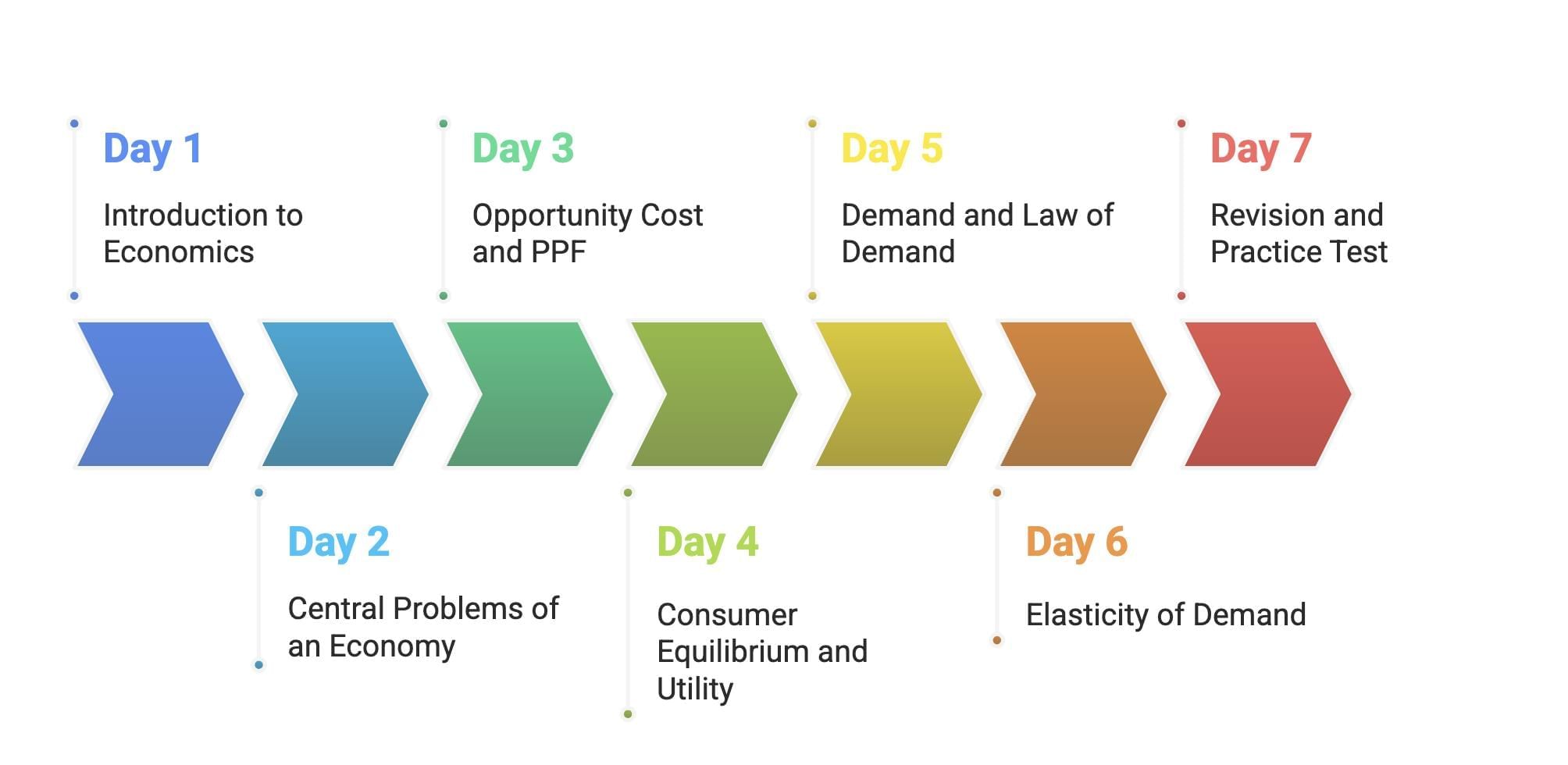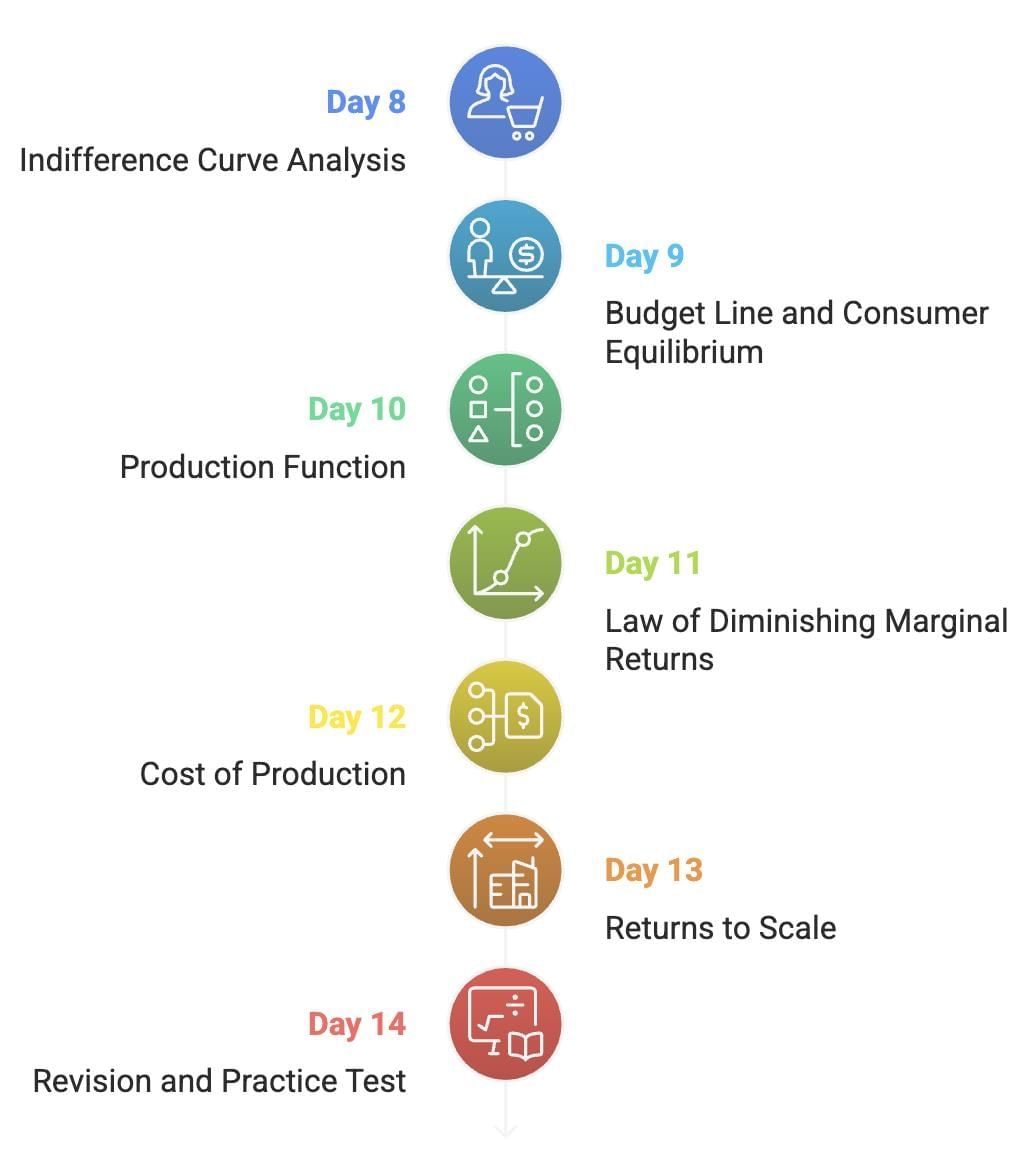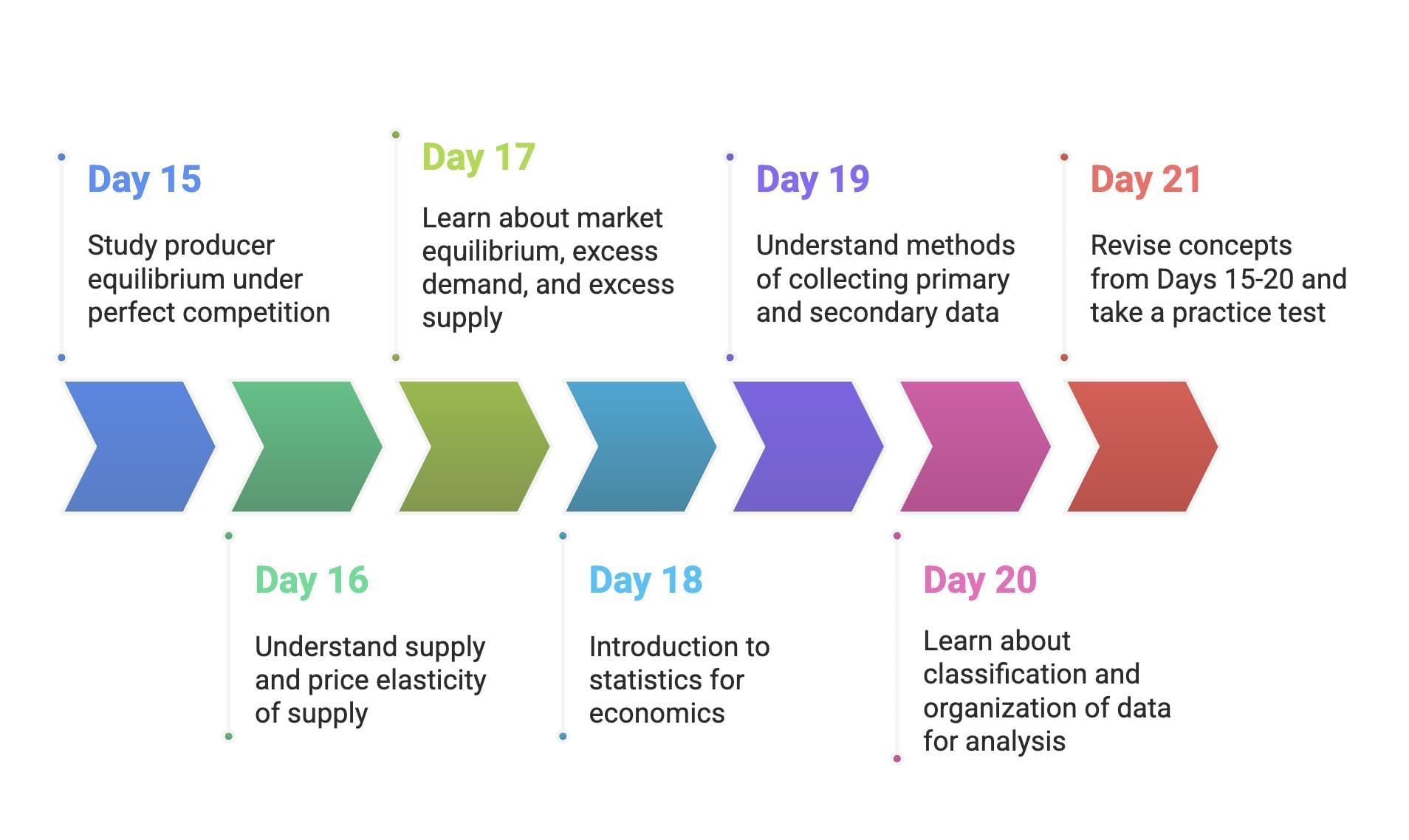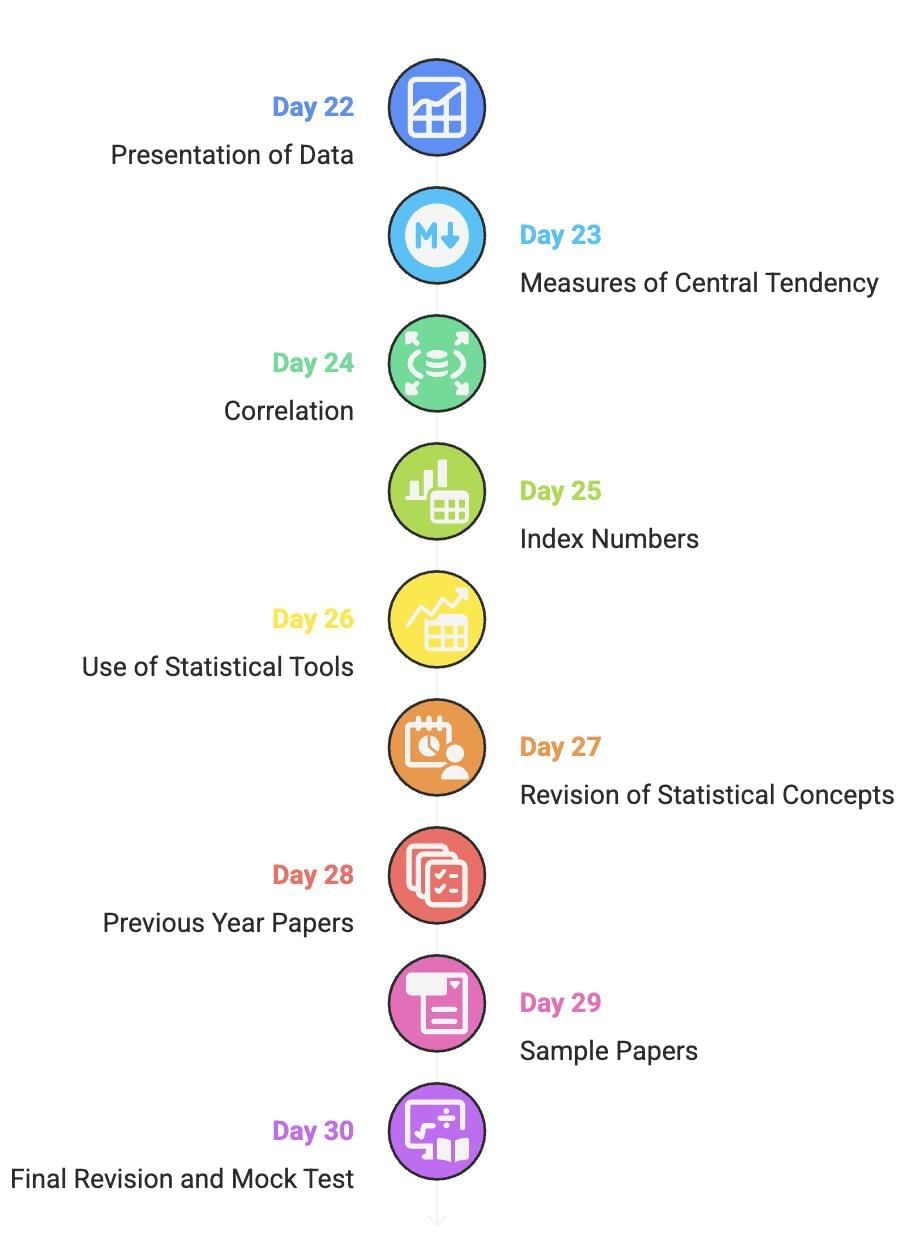30-Day Study Plan: Economics Class 11 | Economics Class 11 - Commerce PDF Download
Week 1: Building Foundations in Microeconomics

Day 1: Introduction to Economics
Start with the basics of Economics, understanding its meaning and scope. Learn about the difference between Microeconomics and Macroeconomics.
- Read: Chapter Notes - Introduction to Microeconomics
- Watch: Meaning of Economics
- Task: Revise notes and focus on weak areas.
- Practice: Attempt Test: Introduction To Economics - 1
Day 2: Central Problems of an Economy
Explore the central problems of an economy: what to produce, how to produce, and for whom to produce.
- Read: Central Problems of an Economy
- Study: Scanner - Central Problem
- Task: Write a short note explaining the three central problems.
- Practice: Solve Important Questions: Introduction to Microeconomics
Day 3: Opportunity Cost and Production Possibility Frontier
Understand the concept of opportunity cost and the Production Possibility Frontier (PPF).
- Watch: Introduction to Opportunity Cost
- Read: Production Possibility Frontier
- Task: Draw a PPF diagram and explain marginal opportunity cost.
- Practice: Complete Worksheet: Introduction to Microeconomics- 1
Day 4: Consumer Equilibrium and Utility
Learn about consumer equilibrium, utility, and the law of diminishing marginal utility.
- Read: Consumer Equilibrium - Microeconomics
- Watch: Law of Diminishing Marginal Utility
- Task: Create flashcards for key terms like marginal utility and total utility.
- Practice: Attempt Test: Theory Of Consumer Behaviour - 1
Day 5: Demand and Law of Demand
Study the concept of demand, individual and market demand, and the law of demand.
- Read: Chapter Notes - Theory Of Demand
- Watch: Law of Demand and Demand Curve
- Task: Draw a demand curve and explain factors affecting demand.
- Practice: Solve Short and Long Questions With Answers - Theory Of Consumer Behaviour
Day 6: Elasticity of Demand
Explore price elasticity of demand and its determinants.
- Watch: PPT: Demand and Elasticity of Demand
- Study: Scanner - Elasticity of Demand
- Task: Solve numerical problems on price elasticity.
- Practice: Revise with Mind Map: Introduction to Microeconomics and Mindmap: Theory of Consumer Behaviour
Week 2: Deepening Microeconomics Concepts
Day 8: Indifference Curve Analysis
Learn about indifference curves and their role in consumer behavior.
- Read: Indifference Curve - Microeconomics
- Watch: What is an Indifference Curve?
- Task: Draw an indifference curve and explain its properties.
- Practice: Solve Passage Based Questions: Theory of Consumer Behaviour
Day 9: Budget Line and Consumer Equilibrium
Understand the budget line and how it relates to consumer equilibrium.
- Watch: Introduction to Budget Line
- Study: Chapter Notes - Consumer's Equilibrium and Demand
- Task: Solve problems on consumer equilibrium using indifference curves.
- Practice: Complete Worksheet: Theory of Consumer Behaviour- 1
Day 10: Production Function
Explore the production function and the relationship between total, average, and marginal product.
- Read: Production Function - Microeconomics
- Watch: Relation Between TP, AP and MP and their Curves
- Task: Create a table showing TP, AP, and MP relationships.
- Practice: Attempt Test: Production And Costs - 1
Day 11: Law of Diminishing Marginal Returns
Study the law of diminishing marginal returns and its implications.
- Watch: Law of Diminishing Marginal Products
- Read: Chapter Notes - Production and Costs
- Task: Explain the three stages of production in your own words.
- Practice: Solve Short Questions With Answers - Production And Costs
Day 12: Cost of Production
Understand different types of costs and cost curves in production.
- Read: Cost of Production - Microeconomics
- Watch: Understanding: Costs of Production (with example)
- Task: Draw cost curves (TC, AC, MC) and explain their shapes.
- Practice: Complete Worksheet: Production and Costs- 1
Day 13: Returns to Scale
Learn about returns to scale and their impact on production.
- Watch: Return to Scale - Economics
- Study: Scanner - Production function
- Task: Write a short note on increasing, constant, and diminishing returns to scale.
- Practice: Attempt Test: Production and Costs- Case Based Type Questions
Day 14: Revision and Practice Test
Revise concepts from Days 8-13 and take a practice test.
- Review: Mindmap: Production and Costs
- Task: Focus on weak areas and revise notes.
- Practice: Attempt Test: Production And Costs - 2

Week 3: Advanced Microeconomics and Introduction to Statistics
Day 15: Producer Equilibrium
Study producer equilibrium under perfect competition.
- Read: Producer Equilibrium - Microeconomics
- Watch: Revenue and its Curves
- Task: Explain how a firm achieves equilibrium using MR and MC.
- Practice: Solve Scanner - Producer Equilibrium
Day 16: Supply and Elasticity of Supply
Understand the concept of supply and price elasticity of supply.
- Watch: Fun Video: Understanding - Supply and Demand
- Read: Price Elasticity of Supply
- Task: Solve numerical problems on elasticity of supply.
- Practice: Attempt Test: Theory Of The Firm Under Perfect Competition - 1
Day 17: Market Equilibrium
Learn about market equilibrium, excess demand, and excess supply.
- Read: Chapter Notes: Market Equilibrium
- Watch: The Equilibrium Price and Equilibrium Quantity
- Task: Draw demand and supply curves to show equilibrium.
- Practice: Complete Worksheet: Market Equilibrium- 1
Day 18: Introduction to Statistics for Economics
Start with the basics of statistics, its meaning, and scope in economics.
- Read: Chapter Notes - Introduction (Statistics for Economics)
- Watch: Introduction: Statistics for Economics
- Task: Create a mind map of statistical tools and their uses.
- Practice: Attempt Test: Introduction To Statistics - 1
Day 19: Collection of Data
Understand methods of collecting primary and secondary data.
- Read: Chapter Notes - Collection of Data
- Watch: Methods of collecting Primary Data
- Task: List differences between primary and secondary data.
- Practice: Solve Worksheet: Collection of Data- 1
Day 20: Organisation of Data
Learn about classification and organization of data for analysis.
- Read: Chapter Notes - Organisation of Data
- Watch: Organisation and Classification of Data
- Task: Create a frequency distribution table from sample data.
- Practice: Attempt Test: Organisation of Data - 1
Day 21: Revision and Practice Test
Revise concepts from Days 15-20 and take a practice test.
- Review: Mind Map: Market Equilibrium and Mind Map: Collection of Data
- Task: Focus on weak areas and revise notes.
- Practice: Attempt Test: Market Equilibrium - 2

Week 4: Statistical Tools and Exam Practice
Day 22: Presentation of Data
Study tabular and graphical methods of data presentation.
- Read: Chapter Notes - Presentation of Data
- Watch: Introduction on Graphical Representation of Data
- Task: Create a bar graph and pie chart using sample data.
- Practice: Complete Worksheet: Presentation of Data- 1
Day 23: Measures of Central Tendency
Learn about mean, median, and mode, and their applications.
- Read: Chapter Notes: Measures of Central Tendency
- Watch: Introduction: Mean Median and Mode
- Task: Solve numerical problems on mean, median, and mode.
- Practice: Attempt Test: Measures of Central Tendency - 1
Day 24: Correlation
Understand correlation, types, and methods like Karl Pearson’s coefficient.
- Read: Chapter Notes - Correlation
- Watch: What Is Correlation?
- Task: Calculate Karl Pearson’s coefficient using sample data.
- Practice: Solve Test: Correlation
Day 25: Index Numbers
Study index numbers, including consumer price index and weighted index numbers.
- Read: Chapter Notes - Index Numbers
- Watch: Consumer Price Index
- Task: Solve problems on constructing index numbers.
- Practice: Attempt Test: Index Numbers - 1
Day 26: Use of Statistical Tools
Explore the application of statistical tools in economic analysis.
- Read: Chapter Notes - Use of Statistical Tools
- Watch: Use of Statistical Tools
- Task: Write a note on the importance of statistical tools in economics.
- Practice: Complete Worksheet: Use of Statistical Tools
Day 27: Revision of Statistical Concepts
Revise statistical concepts from Days 18-26.
- Review: Mind Map: Measures of Central Tendency and Mind Map: Correlation
- Task: Summarize key statistical concepts in your own words.
- Practice: Attempt Test: Index Numbers - 2
Day 28: Previous Year Papers
Practice with previous year CBSE Economics papers to understand the exam pattern.
- Solve: Class 11 Economics Previous Year Paper - 1
- Solve: Class 11 Economics Previous Year Paper - 2
- Task: Analyze mistakes and review related concepts.
Day 29: Sample Papers
Solve CBSE sample papers to simulate exam conditions.
- Solve: CBSE Class 11 Economics Sample Paper - 1
- Solve: CBSE Class 11 Economics Sample Paper - 2
- Task: Time yourself to improve speed and accuracy.
Day 30: Final Revision and Mock Test
Revise all topics, focus on weak areas, and take a final mock test.
- Review: Syllabus: Economics for Class 11
- Task: Revise all mind maps and notes.
- Practice: Attempt CBSE Class 11 Economics Sample Paper - 4

Tips for Effective Preparation
- Be Consistent: Study 2-3 hours daily and stick to the schedule to cover all topics.
- Use Visual Aids: Create mind maps, diagrams, and flashcards to reinforce concepts like PPF, demand curves, and statistical graphs.
- Practice Regularly: Solve worksheets, tests, and past papers to build confidence and improve problem-solving skills.
- Revise Actively: Summarize concepts in your own words and teach them to a friend to enhance retention.
- Stay Positive: Take short breaks, stay motivated, and maintain a positive mindset to avoid burnout.
|
59 videos|222 docs|43 tests
|
FAQs on 30-Day Study Plan: Economics Class 11 - Economics Class 11 - Commerce
| 1. What are the key topics covered in the 30-day study plan for Microeconomics? |  |
| 2. How can students effectively prepare for their Microeconomics exam? |  |
| 3. What statistical tools are essential for understanding Microeconomics, as outlined in the study plan? |  |
| 4. Why is it important to practice exams as part of the study plan? |  |
| 5. What foundational concepts in Microeconomics should students focus on during the first week of study? |  |





















